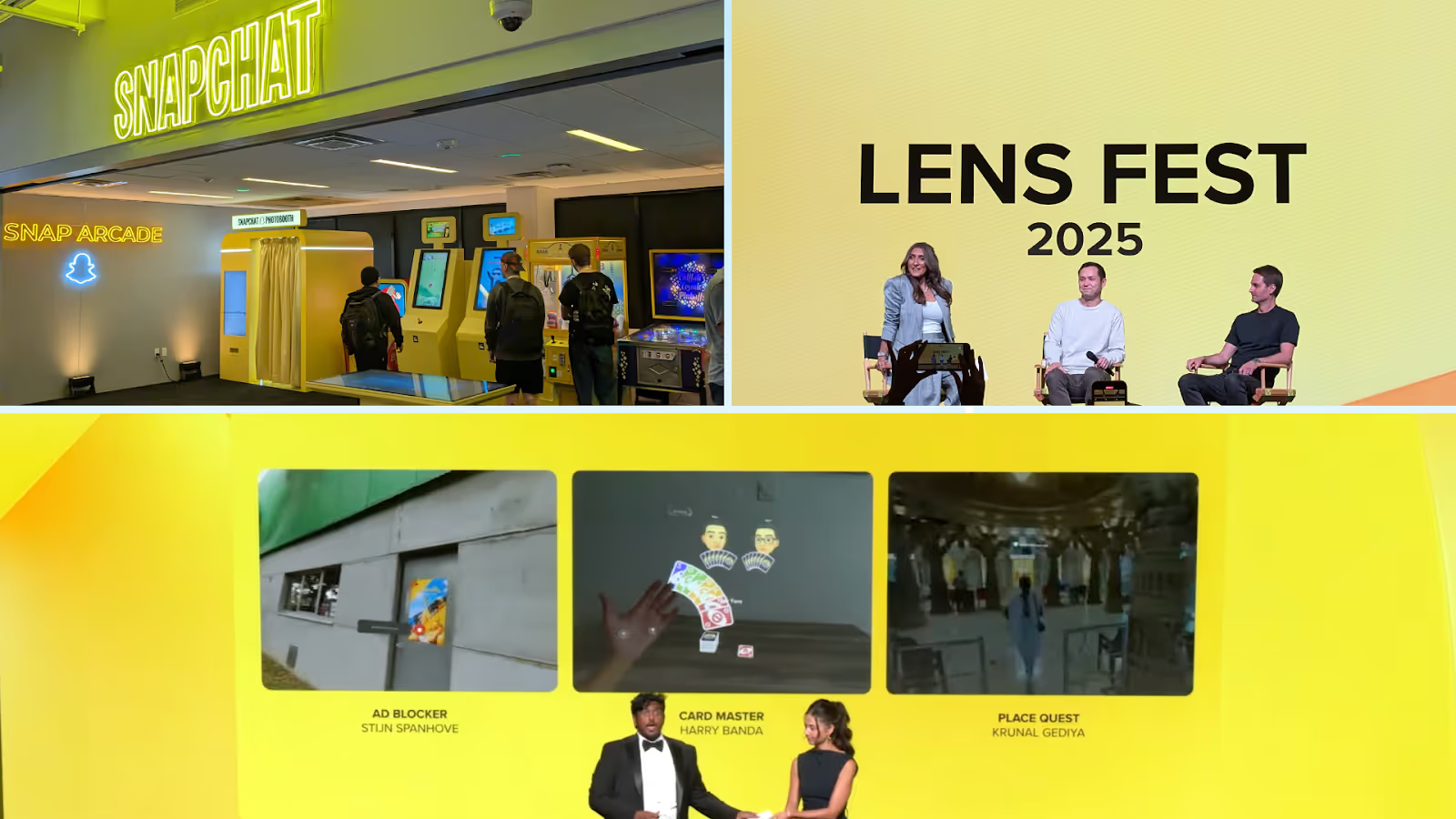In 24 hours at Snap’s Lens Fest, our Engineer, Stijn, helped built Fireside Tales, a gesture-first, multiplayer Spectacles experience where users pass a virtual mic, speak, and toss it into the fire while Supabase syncs stories in real time and GenAI flares matching visuals in the flames; this natural, no-buttons interaction shows reusable patterns for support, training, and collaboration. The prototype reached the finals and placed third, and points to a “build once, deploy across devices” path. For product teams, the takeaways are clear: design for behaviour, prioritise real time, keep teams small, and use simple, scalable metaphors.
Lens Fest 2025 Spectacles Track
Curiosity starts the work, but impact finishes it. When Snap invited me to Lens Fest’s 24-hour Lensathon in Santa Monica, I set out to show how XR glasses can deliver real value fast. The goal was clear: build an XR experience for Snap Spectacles using their new Supabase integration, and prove a path to reliable product delivery at speed. At 13:00, the clock started.
Inside Snap HQ, With 23 Countries in the Room
The Lensathon ran across two tracks. I joined 40 developers from around the world for the Spectacles track. Spectacles are Snap’s XR glasses (currently a developer kit) but already impressive. They use waveguide displays to project visuals directly onto the lenses, and crucially, they support real XR capabilities like hand tracking and six degrees of freedom. The hardware makes natural interaction possible, which is essential for gesture-first UX.

We kicked off with a tour of newly released features. The standout: seamless Supabase integration for rapid back ends in the Snap ecosystem. Then came team formation. I joined a complementary trio, together with Pavlo Tkachenko and Yegor Ryabtsov, one person down versus other teams, which turned into an advantage: less overhead, faster iteration.
Storytelling Around a Virtual Campfire
We wanted something social, simple, and a little magical. Our concept: Fireside Tales, a multiplayer experience where people anywhere in the world can sit “around a campfire” and craft a story together in real time on Snap Spectacles.

How it works:
- A floating microphone appears in your space. Grab it to record your part of the story.
- When you’re done, you throw the mic into the fire.
- Supabase syncs your message instantly with everyone in the room, so the next person can continue.
- As you speak, a fast GenAI model turns moments into images that spark up in the flames.
To make it memorable, we leaned into a marshmallow theme. Every participant becomes a marshmallow character and the GenAI visuals follow that style.
Designing for Natural Interaction (No Buttons, Please)
Good XR should feel instinctive. We built rooms, joining and syncing logic and character selection, but kept the UX gesture-first: grab and throw, point and speak. This approach reduces friction and increases adoption. It is reusable far beyond storytelling, from support to training to collaboration use cases in enterprise XR.
Running on jet lag and a few hours of sleep, we submitted with ten seconds to spare. Then lunch. Then live demos. Hearing the judges laugh at the emergent stories and seeing the visuals pop in the flames made the sprint worth it.
Lens Fest: Looking Ahead With WebXR
Conference day was packed: a keynote from CTO Bobby Murphy, a Q&A with Evan Spiegel, and deep dives into new features. The highlight for me was WebXR support for Spectacles. Build once and deploy across devices: mobile, desktop, headsets, and now Spectacles. That unlocks scalable platforms and faster iteration for product teams focused on AI-driven product development.
I was also up for two Lens Awards with my Ad Blocker lens (Best Spectacles Lens, Most Innovative Lens). I did not win, but I was proud to be nominated and even prouder that Fireside Tales made the Lensathon finals. Speaking of, Fireside Tales made the Lensathon finals. We had eight minutes on the main stage to present and demo. The environment wasn’t ideal, low light and background noise made voice pickup tricky, but we still landed a third-place finish. I’m thrilled with the result, and grateful to Snap for the invite and the platform.

Why It Matters for Product Teams
What did we learn in 24 hours that applies to enterprise product delivery?
What did 24 hours teach us that applies to enterprise XR and beyond?
- Design for behaviour, not buttons: Gesture-first UX and natural interaction reduce friction and help people adopt new tools.
- Real-time sync is the Wow: Supabase made multiplayer feel immediate. That is the standard users now expect.
- Tiny teams, big moves: A small, multidisciplinary team can ship fast without sacrificing quality.
- Simplicity scales: A clear metaphor like a campfire helps users understand and trust new interaction models on scalable platforms.
These principles aren’t limited to XR. They map directly to how we ship reliable, scalable products across platforms, balancing experimentation with the discipline enterprises need to go live with confidence.
Listen to the podcast interview with the 3rd place team in the Snap Spectacles Lensathon featuring Stijn Spanhove, Pavlo Tkachenko, and Yegor Ryabtsov.
Ready to explore gesture-first XR for your organisation? Book a discovery session with our XR team. We’ll map the opportunity, outline a lightweight pilot, and define what success looks like for your users and your business.
Stay ahead
of the game.
Sign up for our monthly newsletter and stay updated on trends, events and inspiring cases.
.avif)




.png)
.avif)